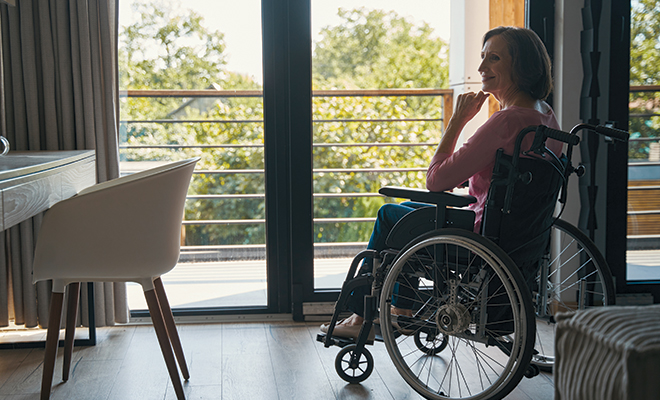
Visitable Homes: Accessible to All
Imagine being unable to find a home to rent or buy because you can’t get through the front door. This problem is faced every day by people who depend on wheelchairs or walkers.
We may not think about basic access until it affects us or someone we know. Suddenly, visiting an inaccessible home means worrying about falling down the front steps or not being able to fit through the front door. You may have to cut your visit short because you can’t access the bathroom.
Visitability, a growing national trend, addresses this problem by promoting accessibility features in new construction. These features support homeowners and visitors who may have disabilities that affect their movement throughout the home.
The National Council on Independent Living, or NCIL, defines a visitable house as meeting these three requirements for universal basic access:
• A zero-step entrance, which means an entrance without a step or threshold on an accessible path without steps.
• Clear entries and passage spaces, with ground floor doors having 32 inches of clear passage and hallways having 36 inches.
• A ground floor bathroom, accessible by wheelchair and large enough to close the door with a wheelchair inside.
Many other features make a home more comfortable, but the NCIL narrowed their list to these three essentials. Besides helping people with disabilities, these basic access requirements can benefit anyone who is temporarily mobility challenged, from homeowners moving furniture to delivery drivers and parents with strollers.
The visitability movement was started by Eleanor Smith and her Atlanta-based organization, Concrete Change, in 1987. According to Smith, “When someone builds a home, they’re not just building it for themselves—that home’s going to be around for 100 years. These things hurt nobody—and they help a lot of other people.”
Smith was herself disabled at three. One day she drove through a new housing tract and noticed all the homes had entrance steps. “I had paid the price of lack of access over and over again, when I could not go to friends’ parties, suffered from being unable to get my wheelchair through bathroom doors when visiting, faced great difficulty finding an apartment or house I could rent,” Smith later wrote. “In fact, I had lived for six months in a home where I had to crawl on the floor to enter the bathroom.”
Depending on a home’s architecture, adding basic access features can be prohibitively expensive or impossible. Living in an unrenovated home is dangerous and the person with a disability may end up feeling like a prisoner in their own home or be forced to move into a nursing home.
Because of the problems with home renovation, the focus of the visitability movement has always been on new home construction. In 1989, the Atlanta affiliate of Habitat for Humanity proved the practicality of visitability in the new construction of single-family homes, building over 20 homes with zero-step entrances at a very low added cost.
Since the early days, the visitability movement has worked to mandate basic access for new housing through policies and laws, not just education. While the Americans with Disabilities Act of 1990 ensures that government buildings, stores and restaurants are accessible to all, there is no corresponding federal law for single-family homes, which are over 70 percent of the nation’s housing.
Florida was the first state to pass visibility legislation with its 1989 Bathroom Law, which required a 29-inch opening for bathroom doors in single-family dwellings. Since then, many local governments across the nation have passed legislation related to visitability and many incentive-based programs have been launched.
At the national level, the Inclusive Home Design Act was first presented to the 108th Congress in 2003. It calls for 95 percent of new single-family housing built with government funding to include visitability access, with the remaining 5 percent having extensive access features. Renamed the Eleanor Smith Inclusive Home Design Act, it was presented to the 117th Congress in 2021. Illinois Representative Jan Schakowsky and other legislators have introduced the bill several times over the intervening years. She has stated that the legislation will aid seniors who want to age at home and veterans with injuries incurred on the battlefield as well as people with disabilities. Besides supporting the three requirements of basic access, the legislation also calls for light switches and thermostats in new homes to be wheelchair accessible.
The visitability movement affects us all, even if we don’t have mobility challenges. You never know when you, a family member or visitor will need a wheelchair or walker. None of us are getting any younger. Wouldn’t it be nice if you knew your home would still be welcoming when you couldn’t move around as well as you used to?
Sources: visitability.org and wbdg.org.







